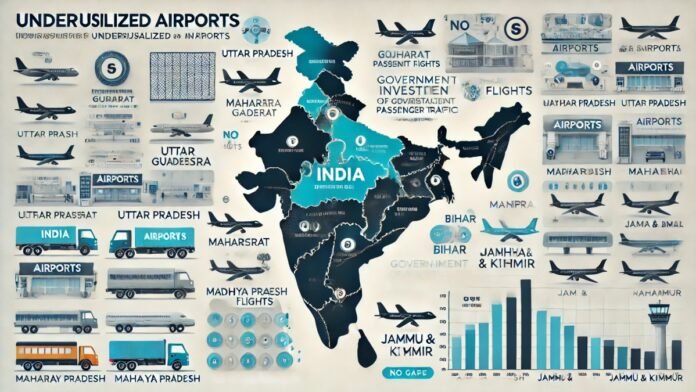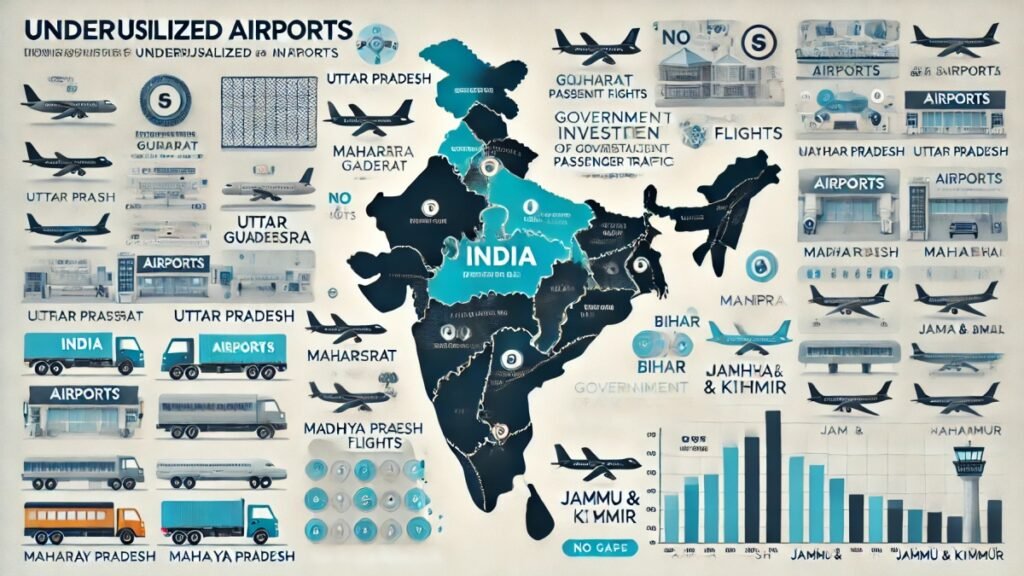
New Delhi: In a striking revelation, 19 airports across India reported zero passenger traffic for the month of September, raising concerns about underutilized infrastructure and inefficiencies within the aviation sector. This issue spans across airports from major states including Uttar Pradesh, Gujarat, Maharashtra, Bihar, Madhya Pradesh, Manipur, and Jammu & Kashmir. Surprisingly, even strategically located airports like Bhopal and Patna found themselves on the list, casting a spotlight on the disconnect between investment and usage.
| Airport | State | Traffic Status |
|---|---|---|
| Bhopal | Madhya Pradesh | No Flights |
| Patna | Bihar | No Flights |
| Imphal | Manipur | No Flights |
| Kushinagar | Uttar Pradesh | No Flights |
| Port Blair | Andaman & Nicobar | No Flights |
| Rajkot | Gujarat | No Flights |
| Tirupati | Andhra Pradesh | No Flights |
| Shirdi | Maharashtra | No Flights |
| Agartala | Tripura | No Flights |
| Vadodara | Gujarat | No Flights |
| Bhavnagar | Gujarat | No Flights |
| Jamnagar | Gujarat | No Flights |
| Srinagar | Jammu & Kashmir | No Flights |
International Airports: A Closer Look at Idle Infrastructure
Despite being designated as international hubs, 15 of India’s 52 international airports also reported no international flights, raising questions about the criteria used to assign international status to these facilities. Airports like Imphal, Shirdi, and Tirupati have yet to serve an international flight, despite considerable infrastructure investments to support international travel.
| Airport | Type | Flights |
|---|---|---|
| Kushinagar | International | None |
| Srinagar | International | None |
| Vadodara | International | None |
| Imphal | International | None |
| Port Blair | International | None |
September’s Domestic Flight Gaps
The Airports Authority of India (AAI) further highlighted that five airports went without any domestic flights during September. These airports include:
| Airport | State | Domestic Traffic Status |
|---|---|---|
| Pakyong | Sikkim | No Flights |
| Rupsi | Assam | No Flights |
| Solapur | Maharashtra | No Flights |
| Hisar | Haryana | No Flights |
| Kushinagar | Uttar Pradesh | No Flights |
Unused Terminals and Runways: The Economic Impact of Idle Airports
The underutilization of these airports comes at a significant economic cost. In recent years, the government has invested heavily in regional airports to improve connectivity and stimulate local economies. Yet, without sufficient air traffic, the infrastructure remains largely unused, revealing issues of demand, planning, and connectivity.
Chart: Investment in Airport Infrastructure vs. Passenger Traffic
While the government has poured resources into developing smaller airports, many have yet to see any return on investment, with empty terminals and unused facilities reflecting deeper issues in India’s aviation sector. This problem is particularly acute in smaller cities and towns where the demand for air travel remains low or inconsistent.
Calls for Strategic Reevaluation and Better Route Planning
Experts are calling for a reassessment of how international and domestic hubs are designated and managed. Ensuring that these airports can sustain both domestic and international traffic requires not only infrastructure but also demand-driven routes, partnerships with airlines, and enhanced marketing efforts to position these airports as viable entry points.
Next Steps: Increasing Connectivity and Demand
To maximize returns on airport investments, the government may need to prioritize initiatives that improve connectivity and make these airports attractive to both domestic and international travelers. Steps could include:
- Developing robust partnerships with airlines to ensure consistent routes to and from these airports.
- Strengthening regional tourism campaigns to promote lesser-known destinations accessible via these airports.
- Reevaluating criteria for international status to focus on sustainable demand and consistent flight operations.

India’s aviation sector faces a critical juncture where infrastructure alone isn’t enough; strategic planning and demand generation are equally essential to bring these airports to life. The challenge now lies in converting these quiet terminals into bustling hubs, transforming potential into operational success.




















































